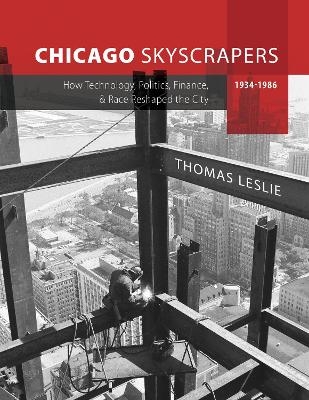
Chicago Skyscrapers, 1934-1986
How Technology, Politics, Finance, and Race Reshaped the City
Seiten
2023
University of Illinois Press (Verlag)
978-0-252-04495-3 (ISBN)
University of Illinois Press (Verlag)
978-0-252-04495-3 (ISBN)
Winner of The Pattis Family Foundation Chicago Book Award, by The Pattis Family Foundation and the Newberry Library
From skyline-defining icons to wonders of the world, the second period of the Chicago skyscraper transformed the way Chicagoans lived and worked. Thomas Leslie’s comprehensive look at the modern skyscraper era views the skyscraper idea, and the buildings themselves, within the broad expanse of city history. As construction emerged from the Great Depression, structural, mechanical, and cladding innovations evolved while continuing to influence designs. But the truly radical changes concerned the motivations that drove construction. While profit remained key in the Loop, developers elsewhere in Chicago worked with a Daley political regime that saw tall buildings as tools for a wholesale recasting of the city’s appearance, demography, and economy. Focusing on both the wider cityscape and specific buildings, Leslie reveals skyscrapers to be the physical results of negotiations between motivating and mechanical causes. Illustrated with more than 140 photographs, Chicago Skyscrapers, 1934–1986 tells the fascinating stories of the people, ideas, negotiations, decision-making, compromises, and strategies that changed the history of architecture and one of its showcase cities.
From skyline-defining icons to wonders of the world, the second period of the Chicago skyscraper transformed the way Chicagoans lived and worked. Thomas Leslie’s comprehensive look at the modern skyscraper era views the skyscraper idea, and the buildings themselves, within the broad expanse of city history. As construction emerged from the Great Depression, structural, mechanical, and cladding innovations evolved while continuing to influence designs. But the truly radical changes concerned the motivations that drove construction. While profit remained key in the Loop, developers elsewhere in Chicago worked with a Daley political regime that saw tall buildings as tools for a wholesale recasting of the city’s appearance, demography, and economy. Focusing on both the wider cityscape and specific buildings, Leslie reveals skyscrapers to be the physical results of negotiations between motivating and mechanical causes. Illustrated with more than 140 photographs, Chicago Skyscrapers, 1934–1986 tells the fascinating stories of the people, ideas, negotiations, decision-making, compromises, and strategies that changed the history of architecture and one of its showcase cities.
Thomas Leslie is an architect, educator, and author. His books include Beauty's Rigor: Patterns of Production in the Work of Pier Luigi Nervi and Chicago Skyscrapers, 1871–1934.
Preface Acknowledgments
Chapter 1. The Second Skyscraper City
Chapter 2. Technical Developments in the 1930s-1940s
Chapter 3. Demographics and Housing
Chapter 4. Prudential, Inland Steel, and the Rebirth of the Loop
Chapter 5. Daley’s City: Commercial Construction, 1955-1972
Chapter 6. High Rise Housing in the 1960s
Chapter 7. Skyscraper Urbanism
Chapter 8. Tubes and the High-Rise as Structural Art
Chapter 9. After Sears
Coda: Mies, Morality, and the Myth of the “Second Chicago School”
Notes
Bibliography
Index
| Erscheinungsdatum | 13.05.2023 |
|---|---|
| Zusatzinfo | 45 color photographs, 101 black & white photographs |
| Verlagsort | Baltimore |
| Sprache | englisch |
| Maße | 216 x 279 mm |
| Gewicht | 1334 g |
| Themenwelt | Geisteswissenschaften ► Geschichte ► Regional- / Ländergeschichte |
| Technik ► Architektur | |
| ISBN-10 | 0-252-04495-9 / 0252044959 |
| ISBN-13 | 978-0-252-04495-3 / 9780252044953 |
| Zustand | Neuware |
| Informationen gemäß Produktsicherheitsverordnung (GPSR) | |
| Haben Sie eine Frage zum Produkt? |
Mehr entdecken
aus dem Bereich
aus dem Bereich


